Deep in the heart of Texas, under that generous sun that showers the earth with its golden rays, our gardens stand on the brink of a glorious transformation. We're embarking on a journey paved with bold intentions and painted with a palette as vast and varied as the Lone Star State itself. We're venturing into a realm where the vivid splashes of native blossoms turn our spaces into living, breathing masterpieces. This isn't just landscaping; it's an act of love, a tribute to Texas's rich botanical legacy that blooms with vibrant life, weaving us closer to the very soul of this land we hold dear.
Drummond Phlox (Phlox drummondii)

This plant bursts onto the scene with its vibrant display of pink, red, and white hues, heralding the arrival of spring in the garden. This dazzling Texas native thrives in a spot bathed in full sunlight, reveling in the glow that helps it achieve its full, colorful potential. To create the perfect home for Drummond Phlox, ensure it's planted in well-draining soil, as soggy conditions can lead to root rot and other issues.
Regular watering is key to keeping this beauty flourishing, especially during dry spells. Aim for a balance by keeping the soil consistently moist but not waterlogged. During the intense heat of midsummer, you may find it needs a bit more hydration to keep up its vibrant display.
Fertilization with a balanced, slow-release fertilizer in early spring can give Drummond Phlox an extra boost, encouraging lush growth and abundant blooms. However, be cautious not to overfertilize, as too much can diminish its floral show.
As the blooming season progresses, deadheading spent flowers can encourage a second bloom, extending the color and life of your Phlox display. In the fall, after the plant has completed its cycle, cutting it back can help keep your garden tidy and ready for the next year's growth.
With just a bit of care and attention, Drummond Phlox can transform your garden into a springtime spectacle, creating a tapestry of color that’s both a feast for the eyes and a beacon for pollinators.
Texas Mountain Laurel (Sophora secundiflora)
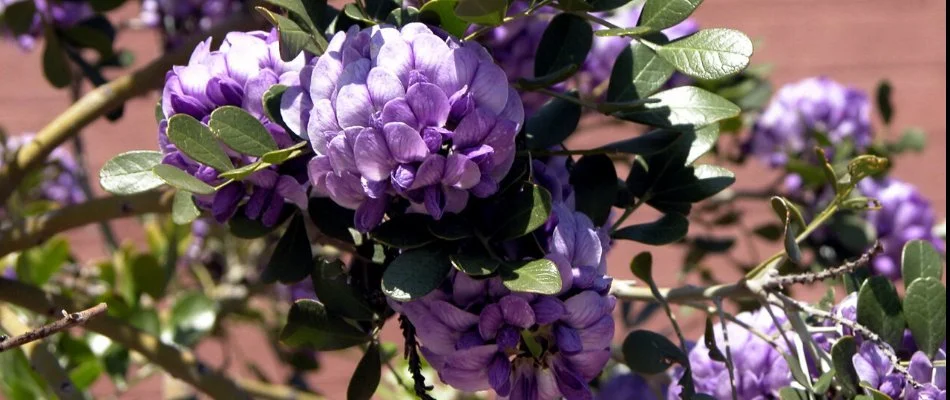
This native gem enchants the senses with its clusters of deep purple blooms that emit a delightful grape-like fragrance. To flourish, the Texas Mountain Laurel seeks a sunny spot where it can bask in the full glory of the sun's rays. This plant embodies the rugged spirit of its native landscape, requiring minimal water once it has firmly rooted itself in its home, showcasing its drought-tolerant nature.
When planting, choose a location that provides protection from harsh, strong winds, which could damage its elegant structure or reduce its flowering potential. The Texas Mountain Laurel thrives in well-draining soil, a crucial aspect of its care, to prevent root rot and other water-related issues.
In its youth, a more regular watering schedule helps establish a robust root system. However, as it matures, it asks for little, content with the rain it receives and only occasionally needs supplemental watering during extended dry spells.
Minimal pruning is necessary for the Texas Mountain Laurel, mostly to shape the plant or remove any damaged branches. This practice keeps it healthy and ensures that its energy is directed toward producing magnificent blooms and fragrant scents.
With patience and the right care, the Texas Mountain Laurel becomes a focal point in the landscape, a testament to both beauty and resilience. It's not just a plant but a sensory experience, offering visual and olfactory delights that enhance any garden setting.
Flame Acanthus (Anisacanthus quadrifidus var. wrightii)
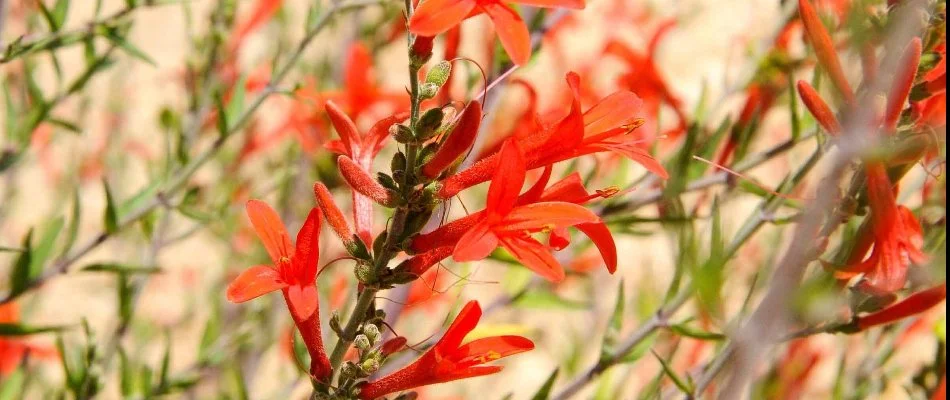
A beacon for both the eyes and the birds, Flame Acanthus sets gardens alight with its brilliant red-orange flowers, drawing in hummingbirds like moths to a flame. This resilient shrub is perfectly suited to the rigors of Texas heat, embracing hot, dry conditions with a flourish that's as fiery as its blooms.
For optimal growth, select a location where the Flame Acanthus can bask in full sunlight—the more, the better. This plant's tolerance for drought is legendary, requiring minimal watering once it's firmly rooted and established. It's a testament to the idea that beauty doesn't always demand high maintenance.
When winter's chill starts to fade, it's time for a bit of grooming. Pruning in late winter not only tidies up your Flame Acanthus but also stimulates it to produce new growth, ensuring that when the warmer months roll around, it's ready to burst back into its fiery display. Cut back the previous year's growth to about a third or to the ground for a bushier and more vibrant plant in the coming season.
In essence, the care for Flame Acanthus is straightforward, making it an ideal choice for gardeners seeking maximum impact with minimal fuss. Its adaptability to less-than-ideal soil conditions, coupled with its drought resilience, means it can thrive in many garden settings, offering a sizzling spectacle that's hard to miss.
Purple Coneflower (Echinacea purpurea)
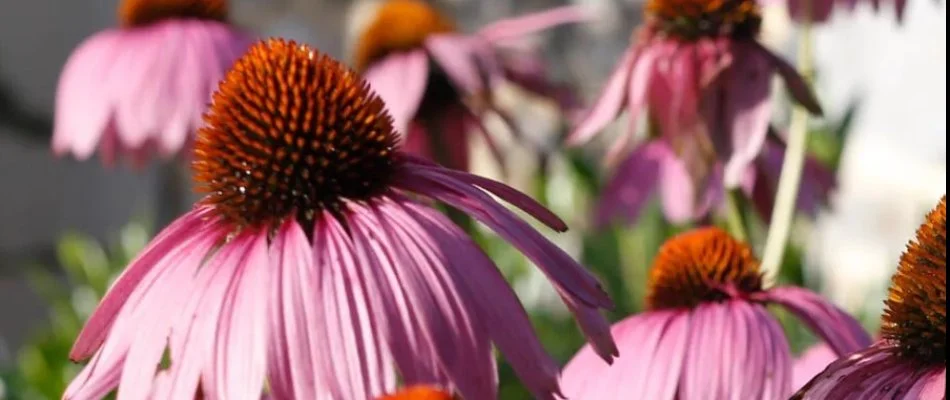
Embellishing the summer garden with its striking purple petals and prominent central cones, the Purple Coneflower stands as a beacon of beauty. This perennial favorite demands a position where the sun freely showers its rays, essential for igniting its vibrant bloom display. Well-draining soil is the bedrock of its health, ensuring that water moves through efficiently to prevent root rot.
To keep the Purple Coneflower looking its best, a consistent watering routine is crucial, particularly during dry spells. Although it's drought-tolerant once established, maintaining moisture in the soil will support lush growth and optimal flowering.
Fertilization isn't typically necessary, as Echinacea thrives in native soil conditions without much help. However, an occasional boost with a low-nitrogen, slow-release fertilizer in the spring can encourage fuller plants and more abundant blooms.
Deadheading, or the removal of spent flowers, not only maintains the plant's appearance but also encourages additional blooms, extending the flowering season. For those who enjoy the presence of finches and other seed-eating birds, leaving some spent flowers in place in the fall can provide a food source.
As winter approaches, consider leaving the plant's stalks standing to offer winter interest in the garden and habitat for beneficial insects. In early spring, cut back the previous year's growth to make way for new shoots.
With minimal care, the Purple Coneflower rewards the garden with a summer-long display of color and a hub of activity for pollinators, enriching the biodiversity of your outdoor space.
Turk's Cap (Malvaviscus arboreus var. drummondii)
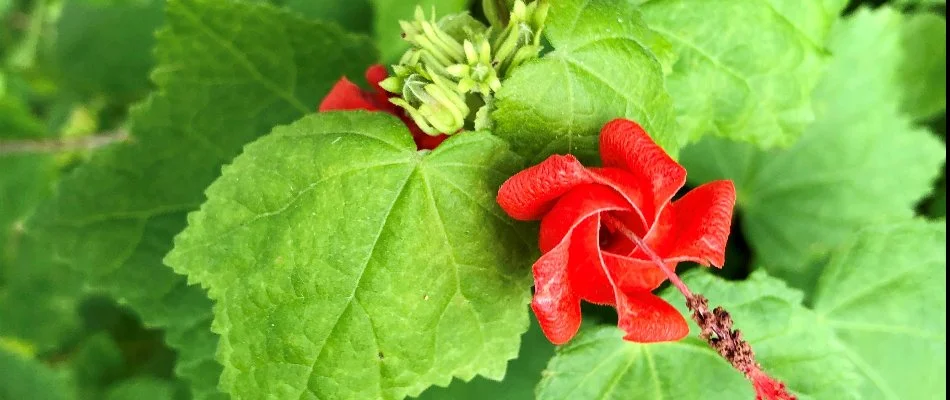
This charming native plant brings a touch of whimsy to any garden with its unique red, turban-shaped flowers that seem to dance among the broad green leaves. Turk's Cap is a standout for shaded or partially shaded areas, thriving where other plants might struggle to bloom. Its ability to flourish in less sunny spots makes it a valuable addition to the diverse garden tapestry.
For Turk's Cap to truly thrive and display its full beauty, maintaining consistently moist soil is key. This plant prefers a well-hydrated environment, so regular watering is essential, especially during periods of drought or extreme heat. However, it's important to ensure that the area has good drainage to prevent water from pooling around the roots, which could lead to issues.
Though Turk's Cap is quite adaptable and can tolerate a range of soil types, incorporating organic matter into the planting site can improve soil structure and nutrient content, enhancing the plant's growth and flowering potential. A layer of mulch around the base can help retain soil moisture, suppress weeds, and keep the root zone cool.
Turk's Cap requires minimal fertilization. A light application of a balanced, slow-release fertilizer in the spring can support vigorous growth and abundant flowering throughout the season. Pruning is not strictly necessary, but trimming the plant in late winter or early spring can help maintain its shape and encourage bushier growth.
With proper care, Turk's Cap will reward you with its distinctive flowers from late spring through fall, attracting hummingbirds and butterflies to your garden. Its easy-going nature and shade tolerance make it an excellent choice for adding color and life to darker corners of your landscape.
Maximilian Sunflower (Helianthus maximiliani)

This plant is a resilient and vibrant perennial that brings a burst of sunshine to any Texas garden. Revered for its towering stems and profuse yellow blooms, it’s a staple for those seeking to add a splash of enduring color and attract pollinators.
Maximilian Sunflowers flourish in full sun. They require at least 6 to 8 hours of direct sunlight daily to produce the most blooms. These sunflowers aren't picky about soil but perform best in well-draining soil. They can tolerate clay, loam, or sandy soils, and even thrive in poor soils where other plants might struggle.
Once established, Maximilian Sunflowers are quite drought-tolerant. Water them deeply but infrequently to encourage deep root growth. During the first growing season, keep the soil consistently moist to help them get established.
Plant Maximilian Sunflowers with plenty of room to grow, as they can reach heights of 3 to 9 feet. Space them about 18 to 24 inches apart to allow for adequate air circulation and sunlight exposure.
These sunflowers generally do not require fertilization if planted in decent soil. Overfertilizing can lead to lush foliage at the expense of flowers. If you decide to fertilize, choose a low-nitrogen option.
Deadheading (removing spent blooms) is not necessary, as the seeds provide food for birds in the fall and winter. However, you can trim the plants in late winter or early spring before new growth begins to keep your garden tidy.
Coral Honeysuckle (Lonicera sempervirens)
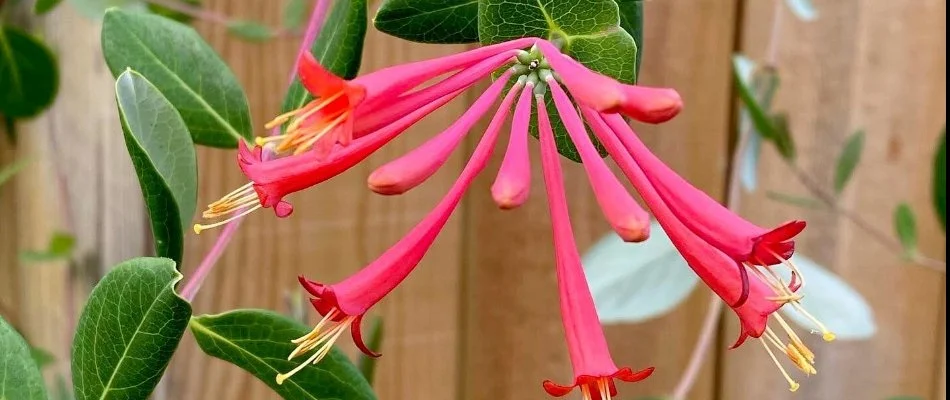
This captivating vine enchants with its tubular red or coral flowers, creating a veritable feast for hummingbirds and butterflies. Coral Honeysuckle is a resilient and low-maintenance addition to any garden, known for its ability to climb trellises, fences, and other structures, bringing vertical interest and vibrant color.
For optimal growth and blooming, Coral Honeysuckle should be planted in a location that receives full sun to partial shade. While it thrives under the full embrace of the sun, some afternoon shade in hotter climates can help protect the plant from excessive heat stress.
Well-draining soil is crucial for preventing root rot and ensuring the health of the plant. If you're working with heavy clay or sandy soils, amend the area with organic matter to improve soil texture and nutrient content.
Regular watering is important, especially during the vine's first growing season, to establish a deep and robust root system. Once established, Coral Honeysuckle becomes quite drought-tolerant, requiring only occasional watering during prolonged dry spells. While Coral Honeysuckle is not a heavy feeder, applying a balanced, slow-release fertilizer in early spring can encourage vigorous growth and an abundance of flowers. Be cautious not to overfertilize, as this can lead to more foliage at the expense of blooms.
Pruning is beneficial for controlling the vine's growth and encouraging a fuller, more manageable shape. Prune Coral Honeysuckle in late winter or early spring before new growth begins. This timing allows you to shape the vine and remove any dead or damaged growth without sacrificing the current year's flowers.
With these care tips in mind, Coral Honeysuckle can become a standout feature in your garden, providing not only aesthetic appeal with its showy blooms but also a vital source of nectar for local pollinators, contributing to the biodiversity of your outdoor space.
Texas Lantana (Lantana urticoides)

This plant is a resilient and vibrant addition to any Texas garden, Texas Lantana captivates with its clusters of bright orange, red, and yellow flowers. This sun-loving plant is a favorite among gardeners for its drought tolerance and ability to thrive in the heat, making it a perfect fit for the challenging Texas climate.
Texas Lantana flourishes in full sun, requiring at least 6 to 8 hours of direct sunlight daily to produce its colorful blooms. It adapts well to various soil types but prefers well-draining soil to prevent root rot. If you're working with heavy clay, consider amending the soil with organic matter to improve drainage.
While established plants are drought-resistant, regular watering during the first growing season is crucial to help Texas Lantana develop a deep, robust root system. Once established, reduce watering, as this plant prefers drier conditions. Overwatering can lead to fewer blooms and potential health issues.
Texas Lantana typically does not require heavy fertilization. If growth seems sluggish or you're seeking more vibrant blooms, you can apply a balanced, slow-release fertilizer in early spring. Avoid overfertilizing, as this can lead to lush foliage at the expense of flowers.
Pruning is beneficial for Texas Lantana, encouraging bushier growth and more abundant flowering. In late winter or early spring, before new growth begins, prune back the plant to about one-third of its size to remove old growth and shape the plant. Deadheading, or removing spent flowers, is not necessary, as Texas Lantana is self-cleaning.
Texas Lantana is generally resistant to pests and diseases. However, keep an eye out for common issues like powdery mildew in overly moist conditions or whiteflies. Proper spacing and airflow around the plants can help prevent fungal diseases.
With its low-maintenance needs and stunning display of colors, Texas Lantana is an ideal choice for gardeners looking to add long-lasting vibrancy to their landscape while also attracting butterflies and other pollinators.
Winecup (Callirhoe involucrata)
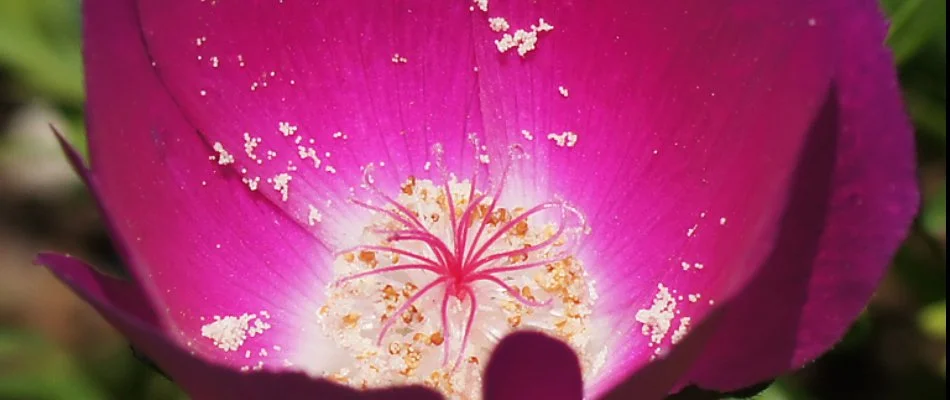
This captivating groundcover graces Texas landscapes with its sprawling habit and striking magenta cup-shaped flowers. Winecup is celebrated for its ability to paint the garden floor with vibrant hues from spring through summer, offering a low-growing burst of color that's both eye-catching and easy to care for.
Thriving under the full embrace of the sun, Winecup requires a minimum of 6 hours of direct sunlight daily to flourish and produce its signature blooms. It's remarkably adaptable to a variety of soil types but has a preference for well-draining soil. If your garden has heavy clay or poor drainage, consider amending the soil with sand or organic matter to improve its structure.
Drought-tolerant once established, Winecup benefits from regular watering during its first growing season to encourage deep root development. After it's settled in, it requires minimal supplemental watering, making it an excellent choice for xeriscaping or in areas where water conservation is a priority. Overwatering should be avoided to prevent root rot and other moisture-related issues.
Winecup generally does not require fertilization, especially if planted in soil that's been amended with organic matter. If growth appears sluggish or you wish to give your plants a boost, a light application of a balanced, slow-release fertilizer in early spring can help, but be cautious not to overdo it, as this can lead to excessive foliage at the expense of blooms.
Minimal pruning is needed to keep Winecup looking its best. Deadheading, or removing spent flowers, can encourage further blooming throughout the season. In late fall, after flowering has ceased and foliage begins to die back, you can trim the plant back to ground level to keep the area tidy and encourage vigorous growth the following spring.
Winecup is largely resistant to pests and diseases, making it a low-fuss addition to any garden. Keep an eye out for common garden pests, but generally, healthy Winecup plants are able to thrive without much intervention. Incorporating Winecup into your garden not only adds a splash of magenta magic but also invites a low-maintenance charm that's hard to resist. Its sprawling nature makes it an ideal choice for filling in bare spots, cascading over edges, or creating a vivid carpet of color in sunny areas of the landscape.
Blue Mistflower (Conoclinium coelestinum)
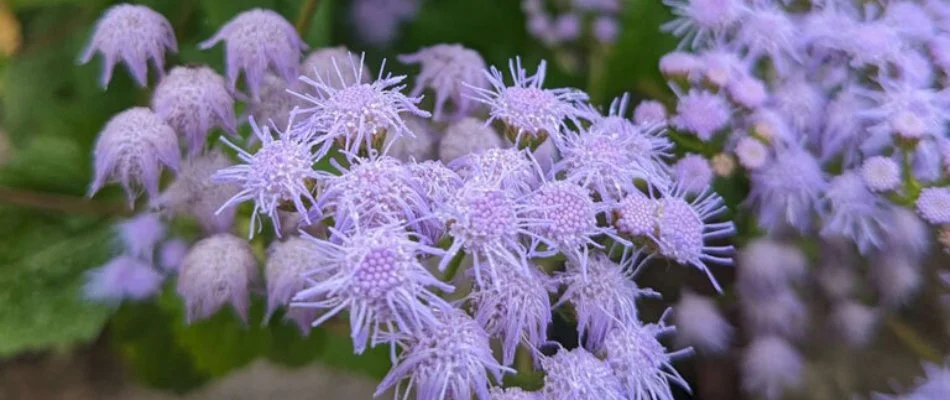
A magnet for butterflies and a beacon of soft blue, the Blue Mistflower transforms the late summer garden into a serene haven. Its fluffy, cloud-like blooms create a dreamy landscape that both gardeners and pollinators adore. Here’s how to nurture these enchanting plants to ensure a garden teeming with life and color.
Blue Mistflower thrives in a range of sunlight conditions, from full sun to partial shade. It's adaptable but favors spots where it can bask in the morning sun while enjoying protection from the harsh afternoon rays. This plant prefers rich, well-draining soil but exhibits remarkable tolerance for various soil types, including those on the heavier or clayey side.
While establishing, Blue Mistflower benefits from regular watering to encourage deep root growth. Once settled, it demonstrates good drought tolerance, although consistent moisture will support more robust blooms. In particularly dry conditions, a weekly watering can help maintain its vibrant display without leading to waterlogged soil.
Generally, Blue Mistflower doesn't demand much in terms of feeding. If planted in poor soil, an application of a balanced, slow-release fertilizer in early spring can give it a boost. Overfertilization should be avoided, as it can lead to excessive foliage growth at the expense of flowers.
To encourage denser growth and more prolific blooming, consider pinching back the tips in early summer. Deadheading is not necessary, as Blue Mistflower will continue to produce new blooms. In late fall, after the first frost, cut the plants back to ground level to tidy up your garden and prepare for next year’s growth.
Blue Mistflower is relatively resistant to pests and diseases. However, in overly moist conditions, it can be susceptible to powdery mildew. Ensure good air circulation around the plants and avoid overhead watering to minimize this risk.
With minimal care, Blue Mistflower adds a layer of tranquility and beauty to any garden setting. Its ability to attract a plethora of butterflies makes it not just a plant but an experience, offering up-close encounters with nature’s most delicate pollinators amidst the serene backdrop of soft blue hues.
Call Us to Schedule Any of Our Landscaping Services
In weaving the tapestry of a dream garden, the artistry lies not just in the vibrant blooms or the lush greenery, but in the meticulous orchestration of plant selection, placement, and care—a symphony our landscaping services master with unparalleled expertise. At the heart of our approach is a profound understanding of the unique character of each plant, the narrative it contributes to your outdoor space, and its role within the ecological ballet of your garden.
Our dedication to expert knowledge ensures that each plant recommendation comes with a deep understanding of its needs, potential, and the harmony it will bring to your landscape. We pride ourselves on crafting spaces that are not only aesthetically stunning but also sustainable and thriving, tailored to the unique conditions of your garden and the climate it resides in. The careful placement of each botanical element, from the majestic tree that offers shade to the delicate ground cover that carpets the earth, is executed with precision and creativity. Our designs are living landscapes that evolve, offering endless discovery and delight with each passing season.
Beyond the initial design and installation, our commitment extends to the ongoing care of your garden. We equip you with the knowledge and support needed to nurture your space, ensuring it continues to flourish and captivate. Our team is always on hand to advise, whether it's adjusting to the changing needs of your garden, tackling unexpected challenges, or planning for future growth. In choosing our landscaping services, you're entrusting your outdoor space to experts passionate about bringing beauty and balance to your environment. Together, we'll create a garden that not only reflects your vision but also becomes a cherished extension of your home—a place of respite, joy, and natural splendor that endures. These services are available in Fort Worth, Arlington, Weatherford, and other nearby areas in Texas. Call us at (817) 880-6052 to schedule any of them!




Comments (0)
Thanks for your comment!
Thanks for your feedback! Your comments have been successfully submitted! Please note, all comments require admin approval prior to display.
Error submitting comment!
There is a problem with your comment, please see below and try again.